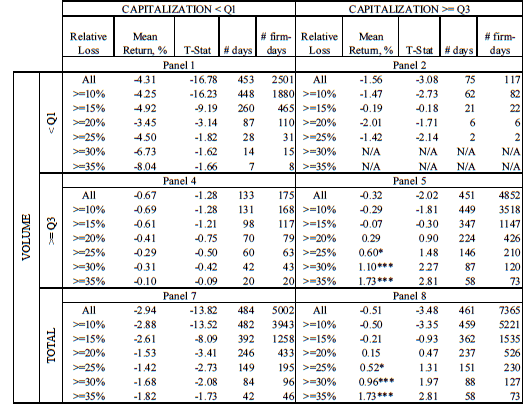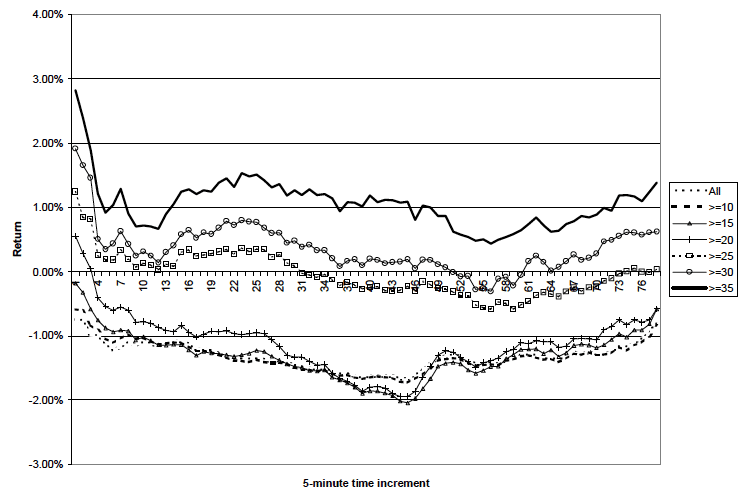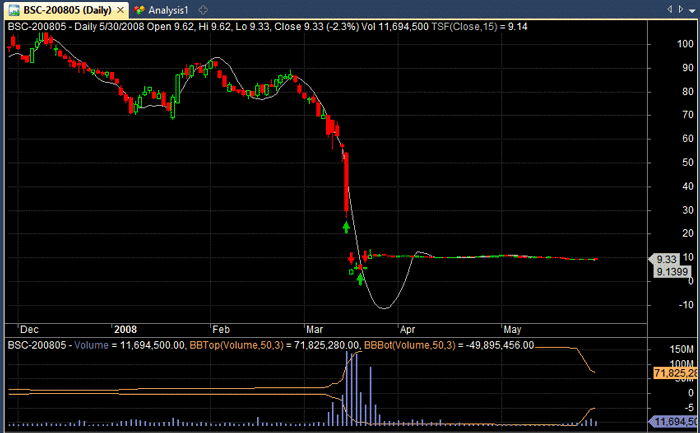I like to keep track of academic papers listed on the Social Science Research Network. The site has a number of interesting journals that can often be the inspiration for new trading strategies and ideas. And it was the perusal of SSRN that was the inspiration for this overnight stock trading system for stocks.
Overnight stock trading system
I was surprised to find a relative wealth of research into the effect of overnight returns in the stock market, both on SSRN and on the trading strategy resource Quantpedia.
One strategy suggests that traders should buy the S&P 500 at the close every evening and sell the trade on the next open, such is the significance of the overnight effect on stocks. Upon further analysis, however, it seems that this particular strategy becomes unprofitable once transaction costs are taken into account.
One paper that caught my eye was Large Price Declines, News, Liquidity, and Trading Strategies: An Intraday Analysis, from Fehle and Volodymyr.
The paper looks at reversals and overnight returns in the stock market, and ultimately suggests that large one-day losses often lead to significant reversals overnight.
The authors found that returns from the strategy increase with capitalisation and that returns are highest when there is no significant news story to accompany the loss. They found that the highest gains came from opening the trade on the close and exiting the trade at the next day’s open.
Theory
Investors are known to overreact to unexpected events and price moves. This overreaction may lead to mis-pricing which can then be taken advantage of by initiating a trade in the opposite direction.
Fehle and Volodymyr found that returns increased with the magnitude of event day loss, consistent with the overreaction hypothesis. And they found that reversals were higher for stocks without accompanying news releases, consistent with previous behavioural models.
Methodology
Fehle and Volodymyr obtained stock data from CRSP and intraday stock quotes from New York Trade and Quote (TAQ). They used options data from the CBOE and created a news variable using news samples from CBS.MarketWatch.com during the time period.
The authors then looked for instances of price reversal for stocks posting intraday losses of 10% or more. Their database consisted of 4,715 unique tickers over 492 trading days and a minimum price filter of $5 was used to eliminate illiquid stocks.
Whenever a stock lost more than 10% from the intraday, hypothetical buy trades were placed in the last 15 minutes of the trading session and the trades were closed at five minute increments the following day, from 9:35 am through 4:00 pm.
The authors found that returns were strongest during the first five minutes of the trading day and gains tailed off towards the end of the session.
Importantly, Fehle and Volodymyr were able to directly incorporate transactions costs by basing returns on the average of bid and ask quotes at the moment of execution.
Results
Fehle and Volodymyr found that event stocks (those experiencing intraday losses of 10% or more) saw reversals commensurate with the magnitude of the loss. In other words, the larger the one day loss, the larger was the overnight reversal.
Src: Large Price Declines, News, Liquidity, and Trading Strategies: An Intraday Analysis.
Returns were greatest for stocks that had tradable options markets and no accompanying news story. Returns increased with market capitalisation and trading volume. As well, the best time to exit the trade was on the next day’s open.
Key findings
• Option stocks tend to have higher reversals, possibly indicating that non-option (mostly small capitalization) stocks take longer to correct excessive moves.
• Average returns for stocks in the top volume quartile exceed those for stocks in the bottom volume quartile.
• A trader focusing only on stocks with capitalization and event day trading volume in the top quartiles and with relative event day losses in excess of 30% or 35% achieves overnight portfolio returns of 1.10% and 1.73%, respectively.
• 1 dollar invested at the beginning of the sample period with the gross proceeds continually reinvested into new event portfolios grew to $2.38 for the case of the strategy examined above, yielding an annual return of 54.29%.
Limitations
The authors of this paper do an excellent job of incorporating transaction costs.
One limitation is that basing the strategy around news releases may not be hold true anymore. Financial news coverage has grown substantially since 2000 so it’s now much more unlikely to find an event day loss without any accompanying news story.
The biggest limitation is that the paper is confined to only one trading period – that of 2000 and 2001 – so it’s unclear whether the strategy holds up in more recent periods…
I therefore loaded up Amibroker and my historical stock database and attempted to test the strategy on more recent market data.
Amibroker Analysis
Without access to intraday stock data or the same sample of news stories, it is not possible to replicate the overnight stock trading system completely. However, it is possible to test the basic premise of the strategy.
I therefore programmed my trading software (Amibroker) with the following system rules:
Test One Rules:
• When a stock loses > 10% – 35% intraday, buy on the close.
• Close the position on the next day’s open.
Test One Settings:
• Stock is in the S&P 1500 universe
• Volume is greater than 1,000,000
• Open price greater than $5
• Position size set at 25%
• Starting capital = $100,000
• Commissions = $0.01 per share
Test One Results:
As you can see from these tables, our results are not particularly consistent with the paper discussed. This is to be expected, since our rules are not exactly the same.
Still, it’s interesting to see that we achieved fairly similar results during the data period 2000-2002 and saw annualised returns over 50%, like the paper did.
However, we did not see returns increase with the magnitude of the event day loss. Instead, we saw the number of trades decline substantially.
Test Two
Keeping everything the same, we can now move the test forward and see how this strategy performed over more recent data periods.
Test Two Results

As you can see from the table, the excellent returns experienced in 2000-2002 were not repeated in subsequent years between 2002-2015. The best performing run gave us a CAR/MDD of just 0.17 so the logical conclusion is that the strategy no longer performs as it once did.
It’s highly likely that the edge from this system has been arbitraged out of the market.
In 2000-2001, the system made a lot of money by entering into overnight reversals on stocks that dropped over 20% intraday. The frequency of these large intraday drops has decreased in recent years as the markets have become more efficient. Meaning that these profitable trades are less common and this was directly seen in the market between the sample period of 2000-2010.
Furthermore, the strategy saw some big losers during the financial crisis. For example, the strategy bought Bear Stearns on 3/14/2008 after a big intraday loss. The stock opened the next day lower by 90%, all of those losses coming overnight.
This shows the merit of the rule regarding the impact of news stories. As the paper suggests, stock returns are greater when there is no accompanying news story for the loss. And in this situation, a responsible trader would be able to avoid entering a trade in a company that was on the brink of bankruptcy.
As a result, this strategy might be another one to benefit from the human touch.
Test Three
Although the system results have clearly deteriorated, there might still be potential for this strategy, if we can diversify our risk, modify the rules and attempt to avoid the worst losing trades.
I, therefore, decided to do some more investigation into the system and see if a worthwhile, profitable strategy could yet be developed.
In test three, I make some changes to the original system in order to see if the strategy might still be useful.





I just came across an infomercial about overnight trading making 100% profit/trade. It seemed too good to be true and I searched the Internet and came across the work that you did on this system. I was very interested in pleased to be able to read your report although it seemed like you had some further ideas about how to possibly make the system work. It you suggested that you are looking at other options but it was not included in the article. If you have further thoughts on this I would be interested in reading them.
I have looked over your list of courses and found it very interesting. I look forward to taking one or more of them in the future.
Thanks for the message. The overnight trading strategy is a very interesting one which shows potential for promising returns with some tweaks.
Joe, when will you have the updated trading strategy with the tweaks?
Thanks!
Mike
There is one on our course called Overnight Reversal. I’m also going to publish one that I’m calling circuit breaker.